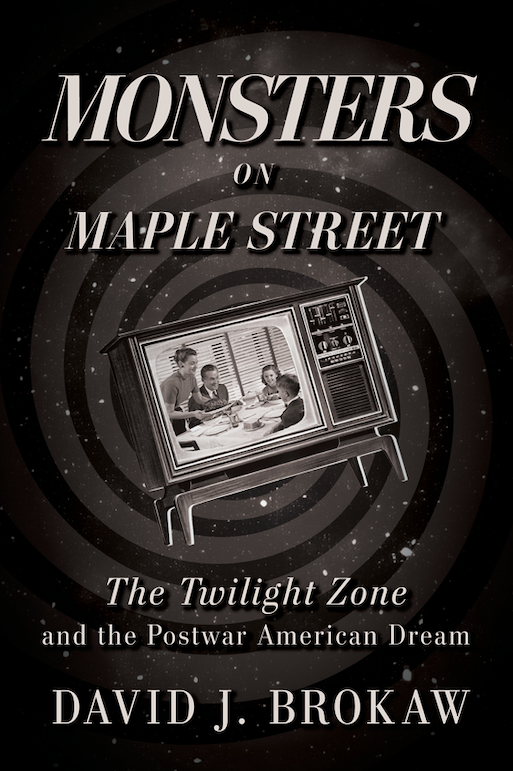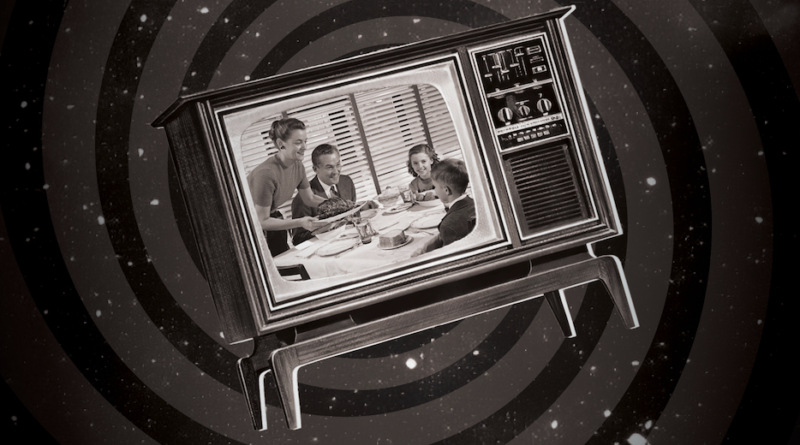REVIEW: ‘Monsters on Maple Street,’ a new ‘Twilight Zone’ book by David J. Brokaw
Image courtesy of University Press of Kentucky / Provided with permission.
David J. Brokaw’s new book, Monsters on Maple Street: The Twilight Zone and the Postwar American Dream, is a dream come true for fans of the science-fiction series who want to delve deeper into the many important themes of Rod Serling’s creation. Although the book is academic in nature — Brokaw is a professor of history at the University of Advancing Technology, and the book is published by University Press of Kentucky — the findings and viewpoints are accessible for most TV viewers who have entered the fifth dimension on a repeated basis.
Brokaw centers his thoughts and research around several key themes: white supremacy, World War II and combat experience, space exploration and technology, McCarthyism, parenting styles, white-collar employment, and consumption. He structures each chapter by summarizing an important Twilight Zone episode that illustrates his thesis, and he also offers a few asides about adjacent episodes that provide further academic evidence.
What he includes is a moment-by-moment retelling of the episode’s content, including Serling’s opening and closing narration, followed by the theories of several important 20th-century thinkers on the subject at hand. For example, in the “Duck, Cover, and Accuse” chapter, he breaks apart the importance of “The Shelter” episode, which was featured in The Twilight Zone’s third season. Brokaw offers some fascinating and engaging insights about the business of bomb shelters in the postwar period, including how some believed the promotion of shelters to survive nuclear war was akin to humanity heading back into the “cave.” He cites P. Herbert Leiderman and Jack H. Mendelsohn, who argued that taking cover in a shelter essentially turned back the “evolutionary clock.”
The “Duck, Cover, and Accuse” chapter continues with a dissection of one of the most beloved and profound Twilight Zone episodes in history: “The Monsters Are Due on Maple Street,” from season one. In the episode, a small, bucolic neighborhood falls victim to the blame game popularized in the political arena by Sen. Joseph McCarthy, who searched for Communists and Communist sympathizers in the government and other industries. The residents of Maple Street point their fingers at their neighbors when trying to find evidence of extraterrestrial life. The reason they do so is not because of some collection of evidence, but because everyone’s heads are then turned to another suspect. One can escape the spotlight by turning that light on another person, just like the accused “witches” in Arthur Miller’s The Crucible.
Another wonderful episode that receives the introspection treatment is “A Stop at Willoughby,” which features the character of Gart, who works a white-collar job at a New York City advertising agency. He’s upset with his life and can’t seem to keep the boss happy. The pressure of landing and sustaining clients gets to him, and his only respite comes on his train ride home to the suburbs of Connecticut. Gart is able to envision a “perfect” town called Willoughby that is devoid of the stressors one finds in life. Think The Andy Griffith Show’s Mayberry, which itself comes with a lot of criticism and questions about who is included in this so-called perfect vision and who is not.
Along the way, Brokaw offers biographical notes on Serling. There are passages about the TV writer’s military service, his upbringing in Upstate New York and his desire to push the envelope, even though sometimes he needed to change his vision and make good with the network and sponsors. Many well-known intellectuals also receive proper space in Monsters on Maple Street; among them are Betty Friedan, Sigmund Freud, James Baldwin and Vance Packard, among others.
Monsters on Maple Street: The Twilight Zone and the Postwar American Dream continues the legacy of Rod Serling’s television masterpiece by examining and contextualizing important themes found within the iconic characters and plot points of this influential TV series. It’s a must-read for Twilight Zone fans and students of 20th century American history.
By John Soltes / Publisher / John@HollywoodSoapbox.com
Monsters on Maple Street: The Twilight Zone and the Postwar American Dream. By David J. Brokaw. University Press of Kentucky. 267 pages. Click here for more information.


